Post double-teams
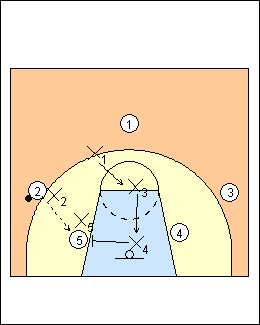 | 1 Need to have strong pressure on the ball. A post double team can be quick (on the pass) or slow (when the post starts an offensive move, or on a dribble). For a quick trap, the defender who comes to trap must sprint on "air time" (with the pass), both hands up. The trappers don't let the post attacker see the weakside, make him pivot away. See Defending - Pistons innings. a) Baseline doubling by the low help defender: X5 defends O5 in front or in a 3/4 high-side position. X2 should be pressuring O2. On a pass to O5, X5 turns O5 towards the baseline. Low help defender X4 (usually the other post defender) runs the baseline to double team on the low side in an "L" trap. X3 drops down to take O4, and X1 sinks to the foul line (a weakside "I"). X2 denies the pass back out to O2 (e.g., face covers). Coaching option - always trap with the same defender, regardless of location (e.g., defender of the weakest attacker). |
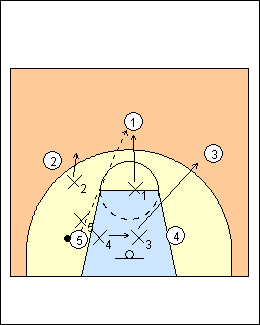 | 2 Use closest-man rotation on a pass out of a trap - the defender nearest the ball closes out, other players rotate to pick up open attackers. With perimeter rotation, perimeter defenders are interchangeable in final match-ups, but post defenders do not rotate out of the paint. With full rotation, all defenders are interchangeable, and the closest-man rule is used for all match-ups. Other possible rotations: a) the defender who came to trap sprints out and takes the free man; b) the trapper who sees the pass sprints out of the trap; c) all defenders recover to their checks. Players rotate as the ball leaves the passer's hands, with the defender in a high help position closing out on the attacker receiving the pass. If O5 passes to O1 (most likely), X1 closes out, X3 recovers to O3, and low trapper X4 recovers to O4 (perimeter or full rotation). X1 looks to steal the pass to O1. Trappers don't foul since they aren't the ones who get the steals. |
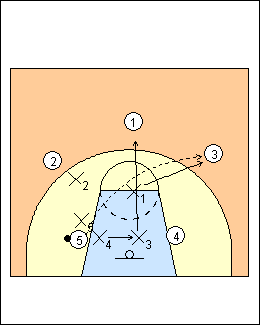 | 3 On a skip pass to O3, X1 closes out and - X3 takes O1, X4 recovers to O4 (perimeter rotation, shown); or - X5 takes O1, X4 stays with O5, X3 stays with O4 (full rotation). Full rotation can give quicker close-outs, but result in mismatches and take post defenders out of defensive rebounding positions. If O5 dribbles out to the corner, one option is for defenders to recover to their players, but another is to stay with the double since you are trapping a post player dribbling and in the corner. |
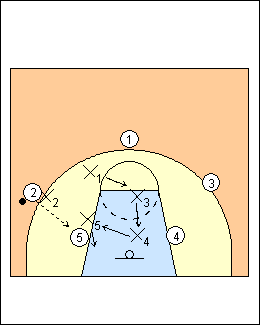 | 4 b) Doubling on top by the low help defender: On the pass to O5, X5 turns O5 towards the middle, X4 rotates to double team on the high side. X3 drops down to take O4, and X1 sinks to the foul line. X5 must not get beat baseline, and slides behind O5 as the ball is in the air. For rotations out of the trap, see baseline doubling by the low help defender. Note that X5 also takes away the baseline in all the remaining post double-teams. coachesclipboard.ca - "Monster" X4 comes in hard with hands high. Monstering is most effective if O5 is a weak passer, O4 is not in constant motion, and if done sporadically. Use the closest-man rule on a pass out of the trap, and X5 stays on O5. |
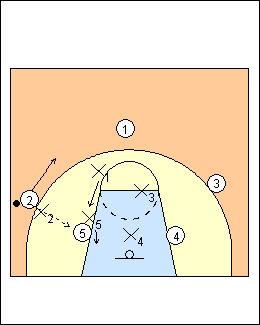 | 5 c) Doubling by the top defender: Doubling with the defender one pass away from the passer is also known as doubling from the top (Jeff Van Gundy, Mike Fratello), the nail (Avery Johnson), or a trap with 2X, who is usually at the elbow (Flip Saunders). On the pass (air time), X5 takes away the baseline and top defender X1 double teams on the high side, with little or no rotation by other defenders. However, the double team may be slow if X1 is in a deny position on O1. Avery Johnson - if trapping on air time and big defender X4 is near a small nail defender then X4 traps, which is more effective at stopping the ball and easier to match up on the pass out since most of the time 4 will dive on the double team. |
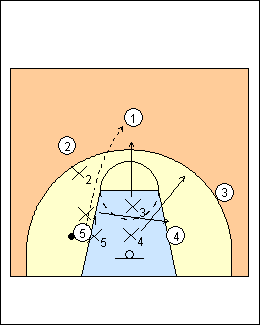 | 6 On a pass to O1, X3 closes out and - X1 takes O3 (perimeter rotation), or - X4 takes O3, X1 takes O4, and needs to front if the ball then goes to O3 (full rotation, shown). Ian MacKinnon - X3 takes a pass out of the trap, X1 goes opposite and has leftovers, i.e., the open attacker (X4 stays with 4). |
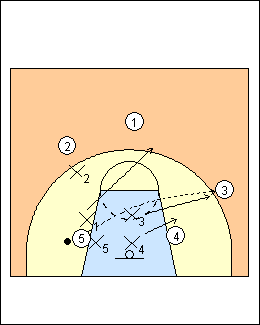 | 7 On a pass to O3, X3 closes out and - X1 takes O1, X4 stays with O4. Perimeter and full rotations are the same. Jeff Van Gundy - X action can be used when a perimeter player is double-teaming the ball in the low post and a skip pass is made. If X1 will have trouble closing out on O1 when O5 passes to O3, X2 takes O1 and X1 takes O2 (x-action by X1 and X2). |
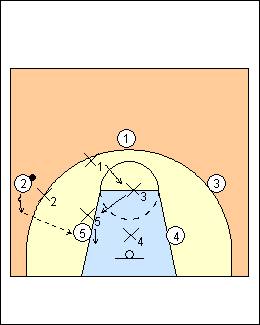 | 8 d) Doubling by the high help defender: Flip Saunders - trap with 3X. When O2 passes to O5, X5 turns O5 towards the middle, high helpside defender X3 rotates down to double team, X1 rotates down to the foul line. X4 stays with O4, so O4 is never open. See doubling from the top for rotations out of the trap. |
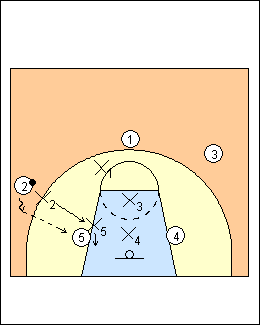 | 9 e) Doubling by the defender of the passer: Flip Saunders - trap with 1X. X2 follows the pass to double team O5 from the top, or digs then recovers. Little or no rotation by other defenders. If O2 "Laker" cuts baseline or middle to the other side after passing, X2 will take him to the rim then snap back to double team the ball. Coaching options - X2 traps only if O5 starts to dribble - do not trap with X2 if O2 moves to the corner after passing. |
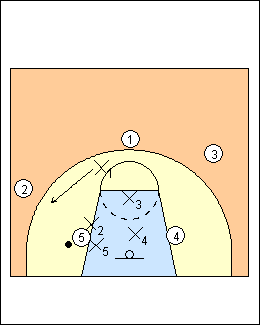 | 10 Option - X1 rotates to pick up O2 (a threat), with rotations out of the trap. |
This page was made with Basketball playbook from Jes-Soft